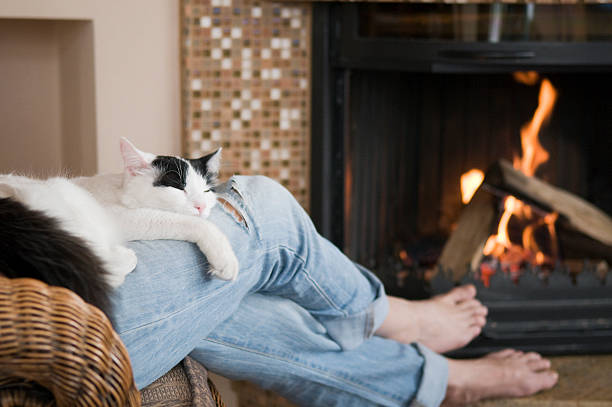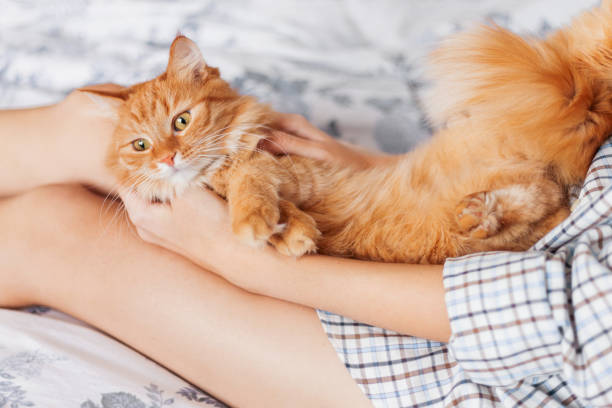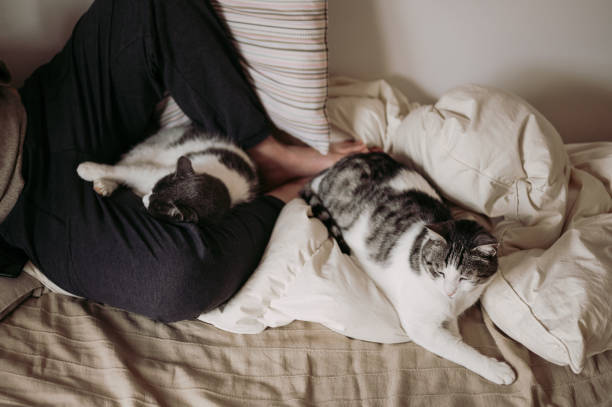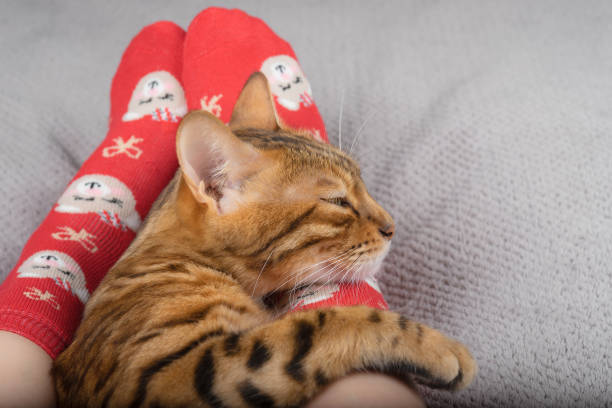You might be puzzled as to why your cat enjoys taking naps between your legs, especially given that doing so means you are unable to easily change positions.
But your cat’s actions are logical for him. If your cat prefers to take naps between your legs, you might be curious about the reason(s) behind their choice. So, let’s find out!
8 Reasons Cats Sleep Between Your Legs
1. Safety & Security
Safety and security are the main factors. Your cat won’t likely suffer any harm while they sleep, but in the wild, this isn’t always the case. Because they can’t defend themselves or flee if a predator charges, wild cats are most vulnerable when they are sleeping.
However, domestic cats inherit these innate feelings of vulnerability when they are sleeping, even though there are no predators hiding in your house. Cats, therefore, look for the safest location imaginable to take a nap.
Their safe haven is with you because you are their beloved and trusted owner. Your cat depends on you for everything, so it stands to reason that they will turn to you for basic needs like a food refill or a litter box change in addition to when they need extra security. They know you will defend them if anything bad were to happen, and there is always safety in numbers — isn’t that wonderful?
It’s frequently preferable to sleep between your legs rather than just next to you because it provides more security. Your cat can curl up next to your legs and be completely enclosed. This is similar to how cats like to sit in cardboard boxes because it is comfortable and safe and keeps them safe from dangers while they sleep.
2. Scent Communication
Cats are fiercely possessive animals who use scent to establish their ownership of a territory. They disperse their scent by applying pheromones, which are unique chemicals, to areas and things they want to claim as their own. These pheromones are undetectable by humans, but other cats can smell them right away and will know to stay away from the area or object if they are present.
Your cat will love to rub these pheromones all over you while you’re lying in bed. Cats get in your face while you sleep to do this, but they can also sleep between your legs to mark you with their scent. They are claiming ownership of you by doing this.
To humans, this “claiming ownership” might sound strange, but it’s your cat’s way of making sure you give your undivided love and attention to them and them alone. They want you all to themselves, and one way to achieve this is through scent communication and territorial marking.
Additionally, if you have more than one cat, you might notice that only one of them likes to nap on your legs. It’s because they’ve designated your lap as their designated sleeping area. Your other cats have been told to find another place to sleep by the pheromones they’ve left behind.
3. Warmth & Comfort
The hottest spot in your home will be sought after by cats, who love to be warm and have a slightly higher core body temperature than humans. Cats are frequently spotted in the last rays of sunlight or close to a radiator. When getting ready for bed, this habit is also true. The warmest place on you at dusk is frequently on you!
Cats that are curled up between our legs or sleeping on them can sense the body heat we emit. Their chances of having a restful night’s sleep are improved because they feel warm and comfortable. For the duration of the night, we serve as their very own hot water bottle.
Not all places a cat might look for warmth are between your legs. For the same reasons that my cat sleeps on my chest, warmth, and comfort. However, this does increase the likelihood that your cat will have their sleep disturbed (see number eight below), so it is less frequent.
Your cat might decide to try sleeping somewhere else if it can’t get cozy on you. In these situations, cats sleep with their faces covered and curl up tightly to feel cozy and warm.

4. Good Vantage Point
My cat sometimes snoozes on top of my legs instead of in between them. Many of the same benefits, such as warmth, safety, and comfort, are also present in this. The fact that it gives your cat a great vantage point from which to see the entire room has an added advantage.
The preference for sleeping on an elevated surface is a natural behavior in cats. Cats in the wild have the best views of what is going on below when they are perched on elevated platforms, which allows them to keep an eye on their prey and predators. Domestic cats still experience the same feelings of comfort and contentment when sleeping high up, despite not being on the lookout.
When your pet is simply trying to feel in charge of its environment during the day, this behavior is also evident. Your cat may have been observing the world around them while perched on your legs or ascending to a high platform.
In your room, your legs might not appear to be on a particularly high surface. They may be the most comfortable option, though, because they are higher than both the floor and your bed. Your cat can observe the activity around them on the bed and the floor below while positioned in this position.
5. Stress & Anxiety
Unfortunately, it isn’t always a good sign when a cat curls up between your legs; this is one of the cat positions that, when they’re sick, may be associated with stress and anxiety. An anxious cat will frequently become more possessive and attached to its owners, sleeping as close to them as possible. This might be on your chest, between your legs, or somewhere else close by.
There are other indications that you should watch out for if your cat is stressed or anxious. Your cat seems to be sleeping more than usual. Are they not using the litter box as they should? Has the child’s behavior changed or have vocalizations gotten louder? All of these signs of cat anxiety!
You should look for the root of the problem so it can be fixed if your cat is stress-related and sleeping between your legs. Perhaps a new person or animal has moved into your house. Your cat may become anxious and uneasy if you make even slight changes to the cat food or litter you use. As creatures of habit, cats can be challenging to manage even the smallest changes.
To help your cat feel more at ease, try to remove the stressor from their environment whenever you can. It’s also a good idea to give your cat access to a number of enclosed, high places where they can hide when they feel threatened. Furthermore, having a ton of stimulating toys and puzzles can help cats who experience separation anxiety avoid getting bored at home.
6. A Bonding Exercise
Cats are social animals who require love and affection, despite their reputation for being distant and independent. In an effort to get to know you better, they are using bedtime as a time of bonding.
Although sleeping between your legs may seem like an odd way to make friends, it is common in the cat community. It is common to see the big cats curling up together to sleep in a pride of lions or other big cat communities.
You might notice that your cats prefer to sleep together if you have more than one cat. This behavior is known as “pillowing”. In order to further cement their familial bond, cats frequently purr while they are pillowing. This is relevant to how mothers and their kittens express their love for one another by purring. Nevertheless, this behavior is still common among a lot of sociable adult cats.
Even if you do have multiple cats, that doesn’t always mean they will sleep together. It’s possible that some cats don’t get along and prefer to spend the night with you rather than with their other feline friends. You shouldn’t be concerned about this as long as your animal companions don’t act aggressively toward one another; some cats simply don’t get along.
In addition, if you live alone with just one cat, it’s possible that your cat prefers to cuddle with you to cuddle with other feline companions. Embrace it as a compliment! It’s an indication of their love and willingness to become your best friend, as well as of their ability to be trusted. if they aren’t already, that is!

7. for Deep Sleep
Cats are experts when it comes to sleeping. They frequently take naps throughout the day and appear to be able to sleep anywhere. Unfortunately, your cat will eventually need to find a secure location for a long, deep sleep since these quick catnaps are insufficient to keep them fit and healthy.
Cats need deep sleep because their bodies can heal, grow, and develop during this phase of sleep. So that they can wake up feeling energized and physically recovered, it helps them to regain their energy.
A cat can fall into a deep sleep on your lap because it has everything it needs. Additionally, if your cat frequently snoozes between your legs, your bed will begin to smell like her, further putting her at ease.
You might be able to tell when your cat is dozing off if you pay close attention. They will appear unconcerned with their surroundings, with a relaxed body posture. As an additional layer of comfort, they may also cover their face with their paw to block out light and noise.
Cats will alternate between this stage of sleep and one known as REM sleep once they are in deep sleep. It is believed that memory and learning are both impacted by this type of sleep. During sleep, does your cat twitch? In this case, your cat is probably experiencing REM sleep, the phase of the sleep cycle during which dreams take place.
8. A Safer Option
Your cat will be awakened and forced to leave if it is sleeping on your chest because you roll over while it is doing so. On the other hand, if you sleep next to a cat, you run the risk of rolling over on top of them in the middle of the night. This is especially true if your bed doesn’t have much room. In this instance, sleeping on the floor is preferred to sleeping between your legs.
All things considered, it seems like a safe and preferable option for a cat that is determined to share your bed to sleep between your legs. Your cat can get the rest they require by being able to turn from side to side without waking them up too much. That’s about as bad as it gets, even if they are gently nudged aside.
What to Do When My Cat Sleeps on My Legs?
It’s great if you’re okay with your cat sleeping between your legs whenever they want to. However, for some owners, it might imply that you’re having trouble falling asleep on your own, getting leg cramps, or waking up when you need to roll over and finding that you can’t fall back asleep.
The solution, in that case, is to figure out a way to gently coax your cat into choosing a different place to sleep. If you want to make them feel warm and comfortable instead, think about getting them a new cat bed with a heating pad. Alternatively, lay down a shirt with your scent on it so they can feel cozy without actually sleeping on you.
Try using clicker training to encourage your cat to sleep next to you if you’re still okay with them sleeping on your bed but don’t want them between your legs. They’ll quickly come to understand that being close to you is almost as enjoyable as being with you because they get treats!

When to Worry About Your Cat Sleeping Between Your Legs?
99% of the time, your cat sleeping between your legs is absolutely fine, and you don’t need to worry about it all unless it’s difficult for you to sleep too.
Your cat may be sleeping more than usual the other 99% of the time because they are ill. Cats are very good at hiding their pain, so if they are stressed or uncomfortable they may look for a warm place to rest. The best course of action is to seek guidance from your vet if you notice any other unusual behavior, such as decreased appetite or drinking, excessive vocalization, or anything else that raises a red flag. They can examine your cat to make sure it has no injuries or illnesses that require medical attention.
Final Thoughts
Why then does your cat enjoy sleeping between your legs? Cats love the sensation of warmth, safety, and security, so while there are numerous potential causes for this behavior, this is the most frequent one. It can also allow your pet to spend the night with you without running the risk of being crushed, making it a great option for cats who need deep sleep or are anxious.
Let your cat sleep in your bed if you’re comfortable with it, and take advantage of the kitty cuddles. If not, try using the aforementioned advice to offer a different bed that they won’t be able to refuse. If you give your feline friend an elevated bed that is warm and smells like you, they will be more likely to get used to the new sleeping arrangements. Even though they are no longer with you, this will give them a sense of security.
If all else fails, make an effort to persuade your cat to sleep on the opposite side of your mattress so that they won’t wake you up. Another crucial thing to keep in mind is that kittens should never sleep in their bed! Before letting your feline sleep close to you, wait until they are older.
